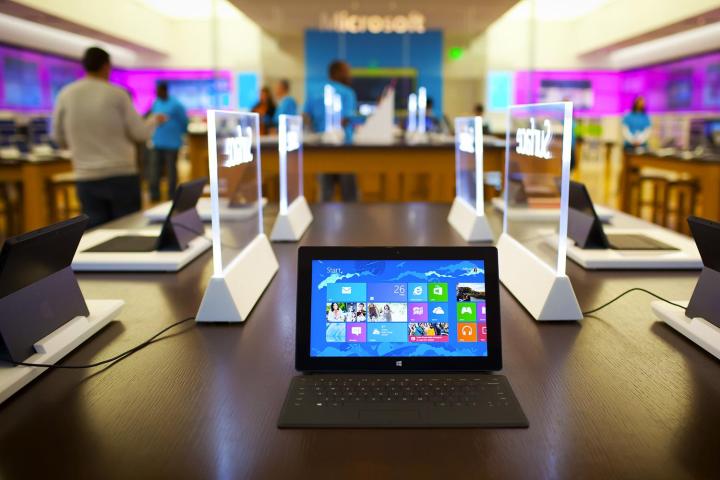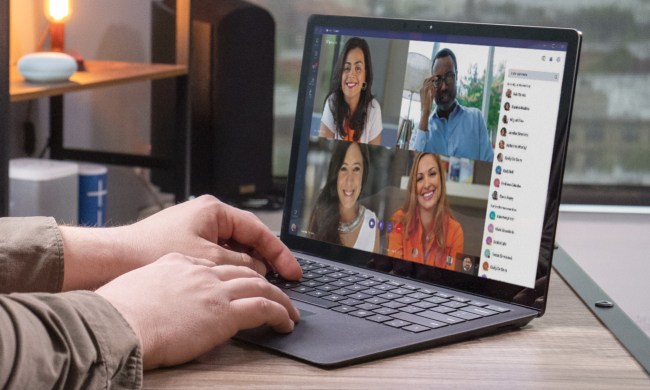
A year ago, Microsoft startled the PC and mobile world by getting into the tablet game with its own Surface RT and Surface Pro devices.
Things haven’t gone that well.
Microsoft hasn’t offered official sales figures for Surface, but the company did take a whopping $900 million writedown last quarter on the entry-level Surface RT alone last quarter, instituted substantial price cuts on both the RT and Pro models, and is now running with a rather desperate-sounding plea to iPad owners to, please, trade in their old tablets.
On paper, the Surface tablets were intriguing technology backed by (arguably) the most powerful software company on the planet. With the next generation of both devices set to be announced Monday, what can Microsoft do to make consumers rethink Surface tablets – and maybe even buy a few?
The paradigm problem
At first glance, Microsoft’s message to consumers about Surface is pretty simple: Look, it’s Windows in a tablet! You can >click!< connect a keyboard! It’s a real PC! Except when consumers looked, what they saw were two things called Surface. The first was RT, which ran a new, weird version of Windows that couldn’t run any existing Windows software. The second, Surface Pro, was bigger and heavier and ran a more robust version of the still new and weird Windows 8 (and it only ran for four hours).

Surface RT and Surface Pro were both outside most consumers’ comfort zones. Surface RT claimed to be a PC, but it didn’t run Windows software. Surface RT also claimed to be a tablet but it didn’t run what consumers consider “tablet” software – because of Microsoft’s anemic app store. Surface Pro is a “real” PC, but despite being able to act as a tablet, it doesn’t make the broader Windows ecosystem tablet-friendly.
Can Microsoft fix it? Microsoft cannot back away from claiming Surface tablets are “real PCs” without undermining its fundamental message. So, it will have to play a long-term strategy of evolving Surface into something that meets what consumers expect from both a tablet and a PC. Microsoft can drive that process with new hardware and new software, but Surface could become something Microsoft can only successfully sell to volume clients dependent on its software and services, like enterprises, governments, health care providers … or the NFL.
Microsoft could expand the Surface brand to new form factors – heck, some of us are old enough to remember when Surface referred to Microsoft’s table-top computing efforts. Rumors have had Microsoft working on a 7-inch tablet (perhaps branded as an Xbox device), but unless it comes with a (very cramped) keyboard it’s hard to see how Microsoft could position a 7-inch tablet as a “real” PC. If anything, Surface devices will likely get larger, and future Windows Phone devices will move into the “phablet” space.
The price problem
Microsoft made good on its word that the Surface RT would be priced like the Apple iPad … but then got undercut by inexpensive Android tablets and the iPad mini. Worse, Microsoft pulled a bit of a bait-and-switch by not including those keyboards that starred in all the advertising. Surface is a real PC, right? Well, a real PC requires a keyboard, but that cost RT users another $120.

“It’s tough to sell a $499 Surface RT tablet that can’t run Windows software when the customer can look over your shoulder at full Windows laptops they already know how to use starting at $399,” said a Best Buy sales supervisor who did not want to be identified because he wasn’t authorized to discuss sales practices. “Surface Pros are an even harder sell: they cost more than notebooks, even some Ultrabooks and convertibles, with a better Windows experience.”
Can Microsoft fix it? Microsoft recently dropped Surface prices substantially: Surface RT currently starts at $349 and Surface Pro at $449, keyboards are now $50 or $100 extra. To create real momentum, Microsoft needs to strongly consider selling Surface devices at or near cost, underselling at least high-end tablets and low-end notebooks and ultrabooks, at least until the platform can offer a truly premium experience.
And if Microsoft wants to make the case Surface is a “real PC,” any Surface device (or at least any Surface device with Office) must come with a keyboard. There’s no excuse for omitting an essential part of the device from the base price.
The hardware problem(s)
Microsoft described Surface tablets as having “no compromises,” but there were no shortage of trade-offs. Where to start? There’s battery life: while Surface RT can run for as long as long as nine hours (basically on par with competitors), Surface Pro is lucky to get four and a half hours – less than Ultrabooks that meet (or exceed) it’s specs. Storage? RT shipped with a generous minimum of 32 GB … but only 16 GB of that was available to users. Things were even worse for Pro: the 64 GB version only had 23 GB available to users, thanks to the sheer size of Windows, Office, built-in apps, and a recovery image. To customers who need storage, that’s a bait-and-switch on par with the (optional!) Surface keyboard – and it wasn’t helped by Microsoft’s basic response to storage concerns being “Uh, use the USB port! Or Skydrive!”

Then, there’s the kickstand, which props up the Surface RT or Surface Pro without a separate case or accessory. Great! However, it’s not adjustable, and the 22-degree (RT) or 26-degree (Pro) angles work on a table or desk, but not on a user’s lap. If users break their kickstands, Microsoft’s official solution is to replace the whole tablet.
Can Microsoft fix it? Expect better performance and more available storage (by using faster processors and perhaps by eliminating 32 and 64 GB options), but also higher screen resolution and improved graphics performance. The next generation of Surface RT will almost certainly have a full HD display, and the kickstand should be adjustable to at least two angles.
Battery life will probably continue to be a problem for Surface Pro: Microsoft won’t want to bulk up the device to increase battery life. I expect Microsoft will “solve” the Surface Pro battery problem via an (optional! and expensive!) attachable keyboard that contains additional battery storage. And, yes, such a keyboard would make the whole Surface Pro package bigger and bulkier.
The Office problem
For most potential customers, what potentially makes Surface RT and Surface Pro a “real” PC is running Microsoft Office. And (with one glaring exception) Microsoft delivered. Surface Pro runs the full Windows version of Microsoft Office; Surface RT runs a stripped-down version of Office: no VBA, macros, or add-ons but most commonly-used features are there. If you need Office on a tablet, Surface has you covered …
… Sort of. In true Microsoft fashion, having Office in Windows RT isn’t exactly, you know, having Office. Surface RT ships with Office 2013 Home & Student edition installed by default; however, technically, that can only be used for work, business, or non-profits if they have a separate commercial license for Office 365. No, that doesn’t unlock any new functionality, it just costs more money. Confused yet? It gets better. Office for Windows RT shipped without Outlook, proving that Microsoft learned nothing from the email- and calendar-free BlackBerry PlayBook. Microsoft is fixing that with Windows RT 8.1, but until then Surface RT users must use Web-based email and calendaring services – fine for some, not for others.

Moreover, simply putting Office on a tablet doesn’t make it usable on a tablet. For decades, Office has been designed with PCs in mind. Although Microsoft redesigned Office 2013 to match Windows 8’s interface, it did almost nothing to adapt Office to tablets. Using Office to do much more than viewing Office documents requires a keyboard. Microsoft software updates mean it’s no longer easy to out-type Word on Surface RT, but apps are still sluggish and it can take a few seconds for even a splash screen to appear.
So, yes: Surface tablets have Office. And, at least in Windows RT, it’s a bit of a hot mess. Competitors are pouncing: Google just announced it’s making Quickoffice (which can view and edit Microsoft Office documents) free for Android and iOS users, not just Google Apps customers. Apple just announced Apple’s well-regarded iWork apps for iOS (Pages, Numbers, and Keynote) will all be free for new iOS devices.
Can Microsoft fix it? Building a full version of Outlook into Windows RT 8.1 is a good first step, but if Office is a key differentiator between Surface and any other tablet, then Surface tablets should simply come with Office, full stop. No license quibbling, no up-charging for commercial use, no missing apps, no gotchas: just Office, pure and simple.
The survival question
Even if it undersells the competition, outperforms other products, resolves design and software issues, and develops a robust software ecosystem, Surface may still not survive. But it’s clear that what Microsoft thought might be an iPad killer has wound up occupying a spot between the withered netbook market and the shrinking PC market … and that’s not a good place to be.


